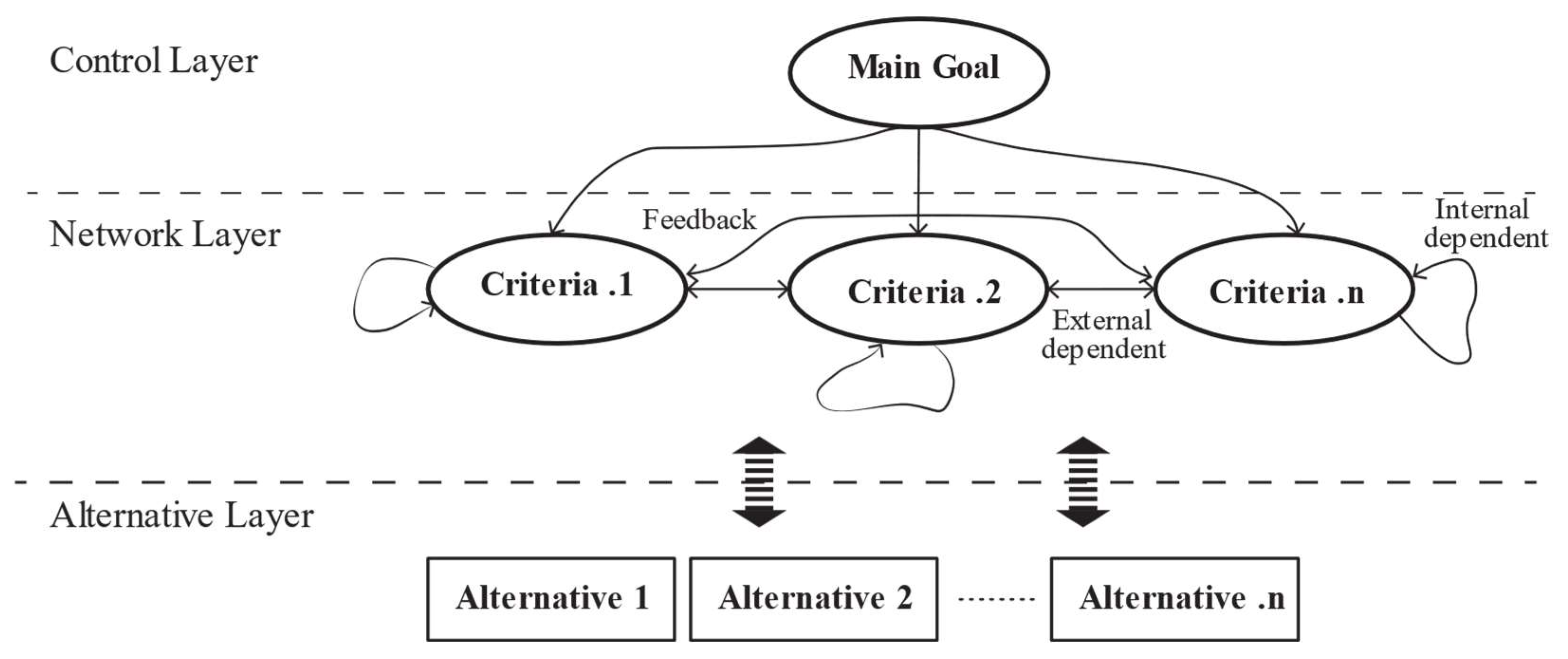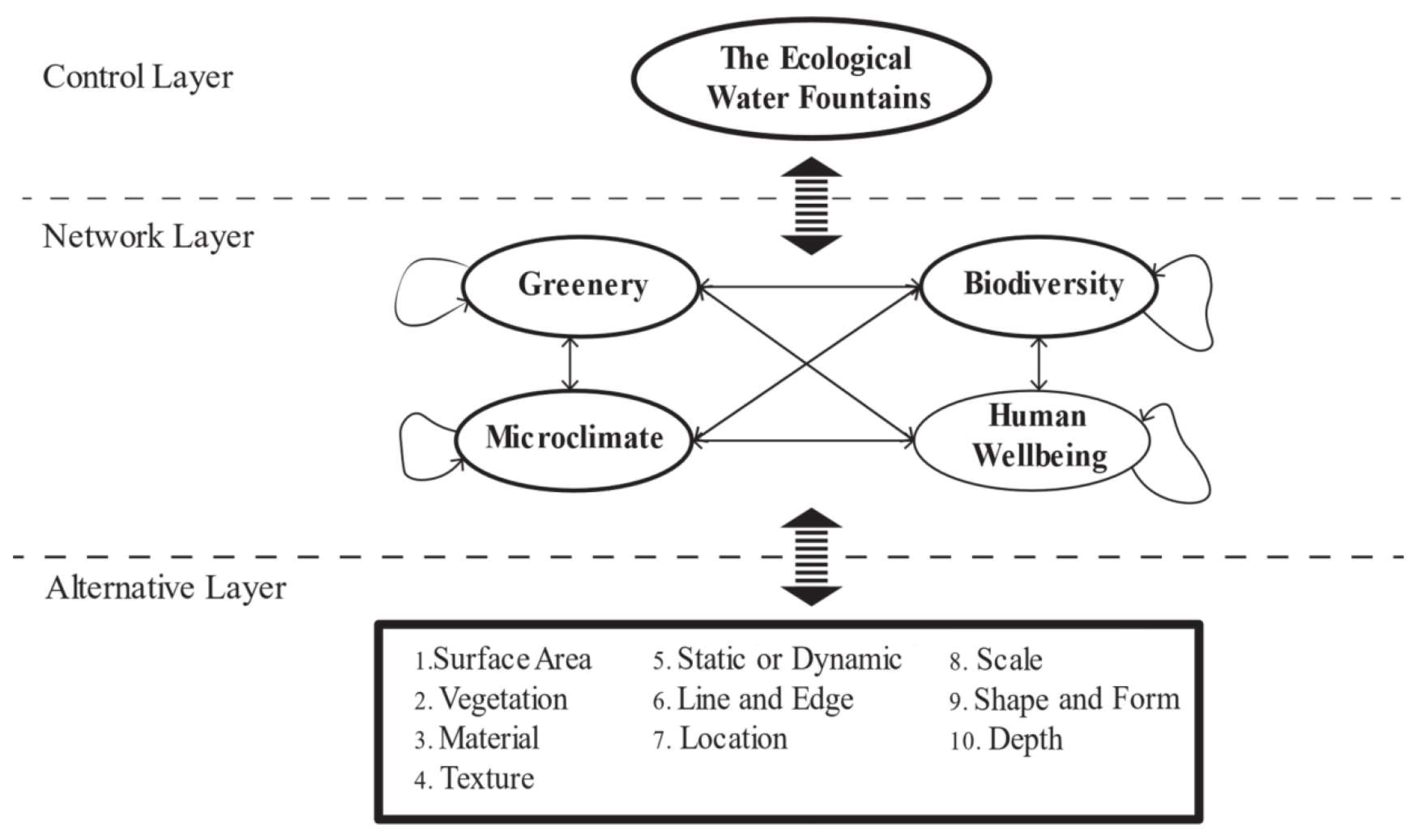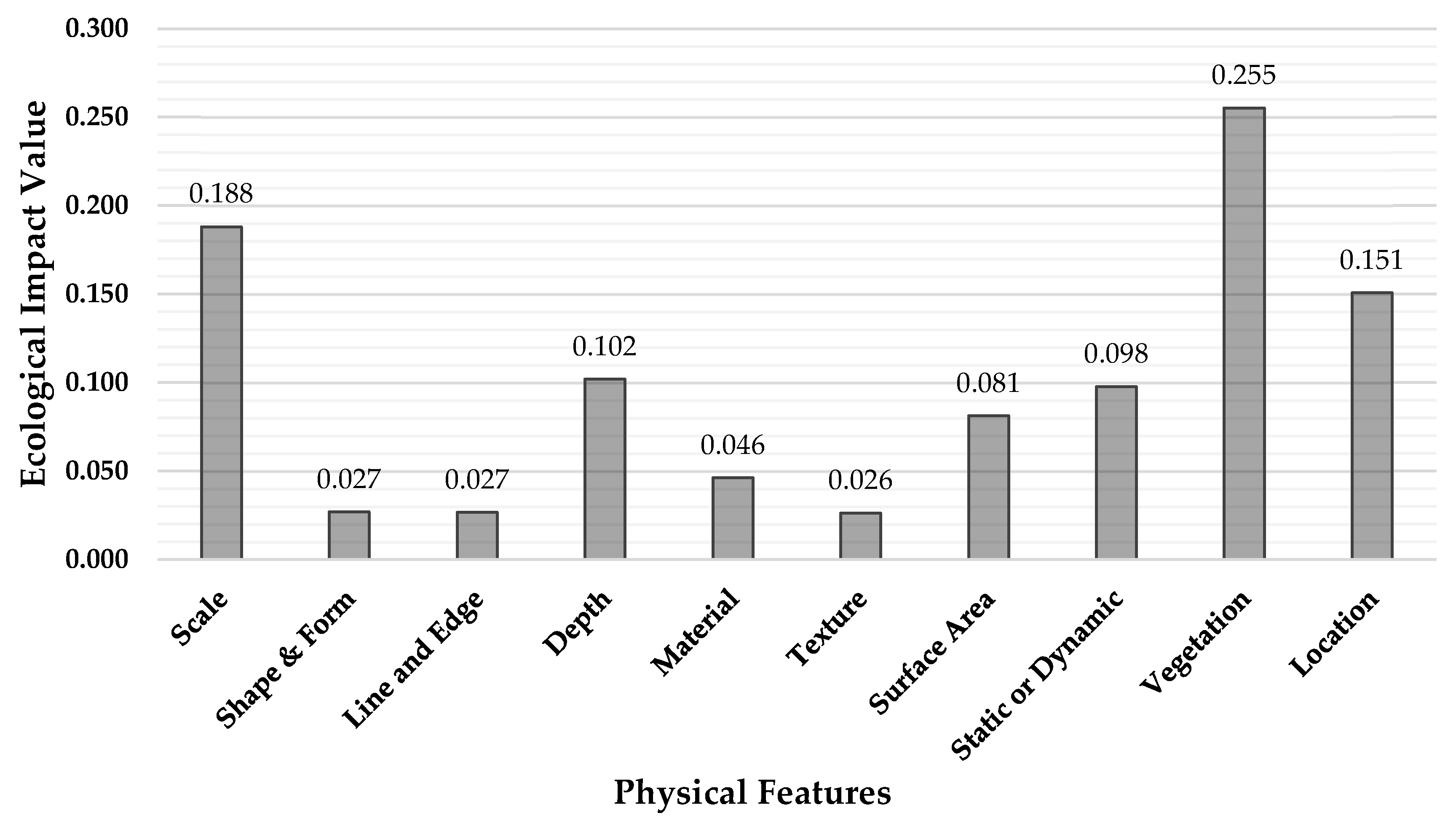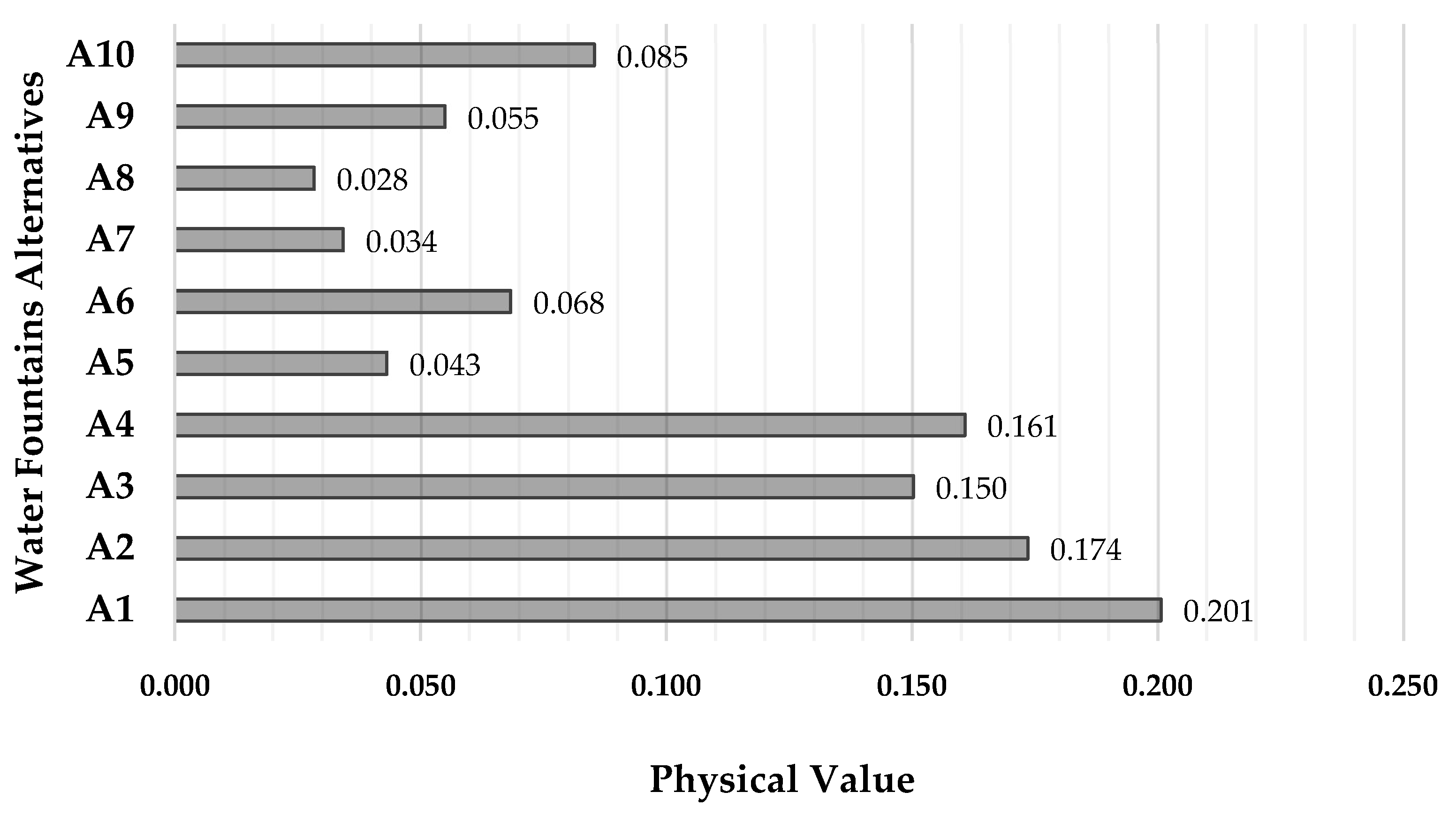A Multicriteria Decision-Making Approach for Urban Water Features: Ecological Landscape Architecture Evaluation
Abstract
:1. Introduction
2. Materials and Methods
2.1. Analytic Network Process
2.2. Mathematical Formula
2.3. The Koohsangi Park Case Study
3. Results
3.1. Ecological Criteria Comparisons
3.2. Impacts of Physical Attributes on Ecological Criteria
3.3. Results of the Case Study
4. Discussion
5. Conclusions
Supplementary Materials
Author Contributions
Funding
Data Availability Statement
Conflicts of Interest
References
- Min, B.W. An Ecological Aesthetic in Sustainable Landscape Design. J. Korean Inst. Landsc. Archit. 2012, 40, 38–48. [Google Scholar] [CrossRef]
- Blau, M.L.; Luz, F.; Panagopoulos, T. Urban river recovery inspired by nature-based solutions and biophilic design in Albufeira, Portugal. Land 2018, 7, 141. [Google Scholar] [CrossRef]
- Hough, M. Cities and Natural Process; Taylor & Francis: London, UK, 2002. [Google Scholar]
- Blaschke, T. The role of the spatial dimension within the framework of sustainable landscapes and natural capital. Landsc. Urban Plan. 2006, 75, 198–226. [Google Scholar] [CrossRef]
- Ferreira, V.; Barreira, A.P.; Pinto, P.; Panagopoulos, T. Understanding attitudes towards the adoption of nature-based solutions and policy priorities shaped by stakeholders’ awareness of climate change. Environ. Sci. Policy 2022, 131, 149–159. [Google Scholar] [CrossRef]
- O’Hogain, S.; McCarton, L.; O’Hogain, S.; McCarton, L. A Technology Portfolio of Nature Based Solutions: Innovations in Water Management; Springer: Cham, Switzerland, 2018. [Google Scholar]
- Frantzeskaki, N. Seven lessons for planning nature-based solutions in cities. Environ. Sci. Policy 2019, 93, 101–111. [Google Scholar] [CrossRef]
- Ferreira, V.; Barreira, A.P.; Loures, L.; Antunes, D.; Panagopoulos, T. Stakeholders’ engagement on nature-based solutions: A systematic literature review. Sustainability 2020, 12, 640. [Google Scholar] [CrossRef]
- Krauze, K.; Wagner, I. From classical water-ecosystem theories to nature-based solutions—Contextualizing nature-based solutions for sustainable city. Sci. Total Environ. 2019, 655, 697–706. [Google Scholar] [CrossRef]
- Abrahem, S.A.; Taha, H.S.; Hassan, S.A. Effect of water features on the microclimate of residential projects in a hot-arid climate: A comparative analysis. Acta Sci. Pol. Adm. Locorum 2022, 21, 5–13. [Google Scholar] [CrossRef]
- Wendel, H.E.W.; Downs, J.A.; Mihelcic, J.R. Assessing equitable access to urban green space: The role of engineered water infrastructure. Environ. Sci. Technol. 2011, 45, 6728–6734. [Google Scholar] [CrossRef]
- Oral, H.V.; Carvalho, P.N.; Gajewska, M.; Ursino, N.; Masi, F.; Hullebusch, E.D.v.; Kazak, J.K.; Expósito, A.; Cipolletta, G.; Andersen, T.R.; et al. A review of nature-based solutions for urban water management in European circular cities: A critical assessment based on case studies and literature. Blue-Green Syst. 2020, 2, 112–136. [Google Scholar] [CrossRef]
- Rentachintala, L.R.N.P.; Reddy, M.M.; Mohapatra, P.K. Urban stormwater management for sustainable and resilient measures and practices: A review. Water Sci. Technol. 2022, 85, 1120–1140. [Google Scholar] [CrossRef]
- Deng, G. Explore the Effective Application of Waterscape in Landscape Design. In Proceedings of the International Conference on Humanities, Cultures, Arts and Design, Sydney, Australia, 7–8 December 2019. [Google Scholar]
- Sandeva, V.; Despot, K. Impact of water in designing landscape. J. Fac. Tech. Technol. Trakia Univ. 2015, 3, 275–281. [Google Scholar]
- Gong, X.; Chen, L.; Tan, S. Evolution of water environment construction and urban landscape ecological risk based on land cover change analysis. Water Sci. Technol. 2022, 85, 2097–2113. [Google Scholar] [CrossRef]
- Syafii, N.I.; Ichinose, M.; Kumakura, E.; Jusuf, S.K.; Hien, W.N.; Chigusa, K.; Ashie, Y. Assessment of the water pond cooling effect on urban microclimate: A parametric study with numerical modeling. Assessment 2021, 12, 461–471. [Google Scholar] [CrossRef]
- Nasar, J.; Lin, Y.-H. Evaluative responses to five kinds of water features. Landsc. Res. 2003, 28, 441–450. [Google Scholar] [CrossRef]
- Semidor, C.; Venot-Gbedji, F. Fountains as a natural component of urban soundscape. J. Acoust. Soc. Am. 2008, 123, 3395. [Google Scholar] [CrossRef]
- Langie, K.; Rybak-Niedziółka, K.; Hubačíková, V. Principles of designing water elements in urban public spaces. Sustainability 2022, 14, 6877. [Google Scholar] [CrossRef]
- Watson, S. Public Water Features: Assembling Publics, Enlivening Spaces, Promoting Regeneration. In City Water Matters; Palgrave Macmillan: London, UK, 2019. [Google Scholar]
- Ferreira, V.; Barreira, A.P.; Loures, L.; Antunes, D.; Panagopoulos, T. Stakeholders’ perceptions of appropriate nature-based solutions in the urban context. J. Environ. Manag. 2021, 298, 113502. [Google Scholar] [CrossRef]
- Külekçi, E.A. Investigation of Plant Designs on Water Surfaces in Terms of Landscape Design. Int. J. Ecosyst. Ecol. Sci. 2020, 10, 683–688. [Google Scholar] [CrossRef]
- Jiang, L. Fountains and Urban Transformations in New York City. Master Thesis, Carleton University, Ottawa, ON, Canada, 2018. [Google Scholar]
- Nesshöver, C.; Assmuth, T.; Irvine, K.N.; Rusch, G.M.; Waylen, K.A.; Delbaere, B.; Haase, D.; Jones-Walters, L.; Keune, H.; Kovacs, E. The science, policy and practice of nature-based solutions: An interdisciplinary perspective. Sci. Total Environ. 2017, 579, 1215–1227. [Google Scholar] [CrossRef]
- Yu, H.; Gu, X.; Liu, G.; Fan, X.; Zhao, Q.; Zhang, Q. Construction of regional ecological security patterns based on multi-criteria decision making and circuit theory. Remote Sens. 2022, 14, 527. [Google Scholar] [CrossRef]
- Addo-Bankas, O.; Zhao, Y.; Gomes, A.; Stefanakis, A. Challenges of urban artificial landscape water bodies: Treatment techniques and restoration strategies towards ecosystem services enhancement. Processes 2022, 10, 2486. [Google Scholar] [CrossRef]
- Silva, M.D.F.M.; Calijuri, M.L.; Sales, F.J.F.; Souza, M.H.B.; Lopes, L. Integration of technologies and alternative sources of water and energy to promote the sustainability of urban landscapes. Resour. Conserv. Recycl. 2014, 91, 71–81. [Google Scholar] [CrossRef]
- Mishra, B.K.; Chakraborty, S.; Kumar, P.; Saraswat, C.; Mishra, B.K.; Chakraborty, S.; Kumar, P.; Saraswat, C. Landscape-Based Approach for Sustainable Water Resources in Urban Areas In Sustainable Solutions for Urban Water Security. In Water Science and Technology Library; Springer: Cham, Switzerland, 2020; Volume 93, pp. 83–113. [Google Scholar]
- Xue, F.; Li, X.; Ma, J.; Zhang, Z.-q. Modeling the influence of fountain on urban microclimate. Build. Simul. 2015, 8, 285–295. [Google Scholar] [CrossRef]
- Nishimura, N.; Nomura, T.; Iyota, H.; Kimoto, S.-i. Novel Water Facilities for Creation of Comfortable Urban Micrometeorology. Sol. Energy 1998, 64, 197–207. [Google Scholar] [CrossRef]
- Gattringer, H.; Claret, A.; Radtke, M.; Kisser, J.; Zraunig, A.; Rodríguez-Roda, I.; Buttiglieri, G. Novel Vertical Ecosystem for Sustainable Water Treatment and Reuse in Tourist Resorts. Int. J. Sustain. Dev. Plan. 2016, 11, 263–274. [Google Scholar] [CrossRef]
- Cai, X.; Xu, D. Application of Edge Computing Technology in Hydrological Spatial Analysis and Ecological Planning. Int. J. Environ. Res. Public Health 2021, 18, 8382. [Google Scholar] [CrossRef]
- Theeuwes, N.E.; Solcerova, A.; Steeneveld, G.J. Modeling the influence of open water surfaces on the summertime temperature and thermal comfort in the city. J. Geophys. Res. Atmos. 2013, 118, 8881–8896. [Google Scholar] [CrossRef]
- Alhazzaa, K. The Influence of Trees and Water Features on Human Health and Thermal Comfort in Hot Arid Climate at The Microclimate Level. Planning 2022, 17, 1579–1584. [Google Scholar] [CrossRef]
- Capon, S.J.; Balcombe, S.R.; Mcbroom, J. Environmental watering for vegetation diversity outcomes must account for local canopy conditions. Ecohydrology 2017, 10, e1859. [Google Scholar] [CrossRef]
- Tserkovna, O. Urban Spaces with Fountains: Noise and Environmental Regime Formation Regularity. Curr. Probl. Archit. Urban Plan. 2021, 61, 256–275. [Google Scholar]
- Abdulkarim, D.; Nasar, J.L. A Splash and a Crowd: Do Water Fountains and Storefronts Improve Plaza’s Visitability? Environ. Behav. 2022, 54, 1171–1194. [Google Scholar] [CrossRef]
- Bozkurt, M.; Woolley, H.; Dempsey, N. Children’s interactions with water in city centres: A case study from Sheffield, UK. Landsc. Res. 2019, 44, 671–687. [Google Scholar] [CrossRef]
- Cox, M.E.; Johnstone, R.; Robinson, J. Effects of coastal recreation on social aspects of human well-being. In Proceedings of the Coastal Zone Asia Pacific Conference, Brisbane, Australia, 2–9 September 2004. [Google Scholar]
- Akinsete, E.; Apostolaki, S.; Chatzistamoulou, N.; Koundouri, P.; Tsani, S. The link between ecosystem services and human wellbeing in the implementation of the European Water Framework Directive: Assessing four river basins in Europe. Water 2019, 11, 508. [Google Scholar] [CrossRef]
- Clifford, C.C.; Heffernan, J.B. Artificial Aquatic Ecosystems. Water 2018, 10, 1096. [Google Scholar] [CrossRef]
- Tribot, A.S.; Deter, J.; Mouquet, N. Integrating the aesthetic value of landscapes and biological diversity. Proc. R. Soc. B: Biol. Sci. 2018, 285, 20180971. [Google Scholar] [CrossRef]
- Chang, Y.-H.; Wu, B.-Y.; Lai, C.-F. A study of the ecological benefits of the green energy landscape fountain. Ecol. Eng. 2015, 75, 128–136. [Google Scholar] [CrossRef]
- Jiang, D.; Hua, R.; Shao, J. Ecological Evaluation of Sponge City Landscape Design Based on Aquatic Plants Application. Land 2022, 11, 2081. [Google Scholar] [CrossRef]
- Bao, Y.; Gao, M.; Luo, D.; Zhou, X. The influence of plant community characteristics in urban parks on the microclimate. Forests 2022, 13, 1342. [Google Scholar] [CrossRef]
- Xing, Y.; Jones, P.J.; Donnison, I.S. Characterisation of Nature-Based Solutions for the Built Environment. Sustainability 2017, 9, 149. [Google Scholar] [CrossRef]
- Krivtsov, V.; Forbes, H.; Birkinshaw, S.J.; Olive, V.; Chamberlain, D.F.; Buckman, J.; Yahr, R.; Arthur, S.; Christie, D.; Monteiro, Y.; et al. Ecosystem services provided by urban ponds and green spaces: A detailed study of a semi-natural site with global importance for research. Blue-Green Syst. 2022, 4, 1–23. [Google Scholar] [CrossRef]
- Manzo, L.M.; Epele, L.B.; Horak, C.N.; Kutschker, A.M.; Miserendino, M.L. Engineered ponds as environmental and ecological solutions in the urban water cycle: A case study in Patagonia. Ecol. Eng. 2020, 154, 105915. [Google Scholar] [CrossRef]
- Saher, R.; Middel, A.; Stephen, H.; Ahmad, S. Assessing the microclimate effects and irrigation water requirements of Mesic, Oasis, and Xeric landscapes. Hydrology 2022, 9, 104. [Google Scholar] [CrossRef]
- Sowinska-Swierkosz, B. Application of surrogate measures of ecological quality assessment: The introduction of the Indicator of Ecological Landscape Quality (IELQ). Ecol. Indic. 2017, 73, 224–234. [Google Scholar] [CrossRef]
- Zhang, J. The Ecological Environment Art Design of Urban Wetland Park: Taking the Landscape Design of Muye Lake Park in Xinxiang City as an Example. Wirel. Commun. Mob. Comput. 2022, 2022. [Google Scholar] [CrossRef]
- Cebrián-Piqueras, M.A.; Filyushkina, A.; Johnson, D.N.; Lo, V.B.; López-Rodríguez, M.D.; March, H.; Oteros-Rozas, E.; Peppler-Lisbach, C.; Quintas-Soriano, C.; Raymond, C.M.; et al. Scientific and local ecological knowledge, shaping perceptions towards protected areas and related ecosystem services. Landsc. Ecol. 2020, 35, 2549–2567. [Google Scholar] [CrossRef]
- Walczak, W.; Serafin, A.; Siwiec, T. Natural Swimming Ponds as an Application of Treatment Wetlands—A Review. Water 2023, 15, 1878. [Google Scholar] [CrossRef]
- Lin, B.; Zhang, Z.; Li, X.; Zhu, Y. Numerical simulation study on the effects of fountain on around thermal environment. In Proceedings of the 10th Conference of IBPSA, BS 2007, Beijing, China, 27–30 July 2009. [Google Scholar]
- Wang, H.; Li, C. Analysis of scale effect and change characteristics of ecological landscape pattern in urban waters. Arab. J. Geosci. 2021, 14, 569. [Google Scholar] [CrossRef]
- Ćwik, A.; Wójcik, T.; Ziaja, M.; Wójcik, M.; Kluska, K.; Kasprzyk, I. Ecosystem services and disservices of vegetation in recreational urban blue-green spaces—Some recommendations for greenery shaping. Forests 2021, 12, 1077. [Google Scholar] [CrossRef]
- Skovira, L.M.; Bohlen, P.J. Water quality, vegetation, and management of stormwater ponds draining three distinct urban land uses in central Florida. Urban Ecosyst. 2023, 26, 867–879. [Google Scholar] [CrossRef]
- Teshnehdel, S.; Gatto, E.; Li, D.; Brown, R.D. Improving outdoor thermal comfort in a steppe climate: Effect of water and trees in an urban park. Land 2022, 11, 431. [Google Scholar] [CrossRef]
- Syafii, N. Promoting urban water bodies as a potential strategy to improve urban thermal environment. Geogr. Pannonica 2021, 25, 113–120. [Google Scholar] [CrossRef]
- Moghim, S.; Takallou, A. An integrated assessment of extreme hydrometeorological events in Bangladesh. Stoch. Environ. Res. Risk Assess. 2023, 37, 2541–2561. [Google Scholar] [CrossRef]
- Tsoka, S.; Tsikaloudaki, K.; Theodosiou, T.; Bikas, D. Urban warming and cities’ microclimates: Investigation methods and mitigation strategies—A review. Energies 2020, 13, 1414. [Google Scholar] [CrossRef]
- Akten, M. Possibility to employ AHP as a multi-criteria decision making method in landscape planning initiatives. In Advances in Landscape Architecture; IntechOpen: London, UK, 2013. [Google Scholar]
- Ishizaka, A.; Nemery, P. Multi-Criteria Decision Analysis: Methods and Software; John Wiley & Sons: Hoboken, NJ, USA, 2013. [Google Scholar]
- Terzi, E. Analytic Hierarchy Process (AHP) to Solve Complex Decision Problems. Southeast Eur. J. Soft Comput. 2019, 8, 5–12. [Google Scholar] [CrossRef]
- Asadabadi, M.R.; Chang, E.; Saberi, M. Are MCDM methods useful? A critical review of analytic hierarchy process (AHP) and analytic network process (ANP). Cogent Eng. 2019, 6, 1623153. [Google Scholar] [CrossRef]
- Saaty, T.L. The Analytic Network Process. In Decision Making with the Analytic Network Process. International Series in Operations Research & Management Science; Springer: Boston, MA, USA, 2006; Volume 95. [Google Scholar]
- Görener, A. Comparing AHP and ANP: An Application of Strategic Decisions Making in a Manufacturing Company. Int. J. Bus. Soc. Sci. 2012, 3, 194–208. [Google Scholar]
- Taherdoost, H.; Madanchian, M. Analytic Network Process (ANP) method: A comprehensive review of applications, advantages, and limitations. J. Data Sci. Intell. Syst. 2023, 1, 12–18. [Google Scholar] [CrossRef]
- Heymans, A.; Breadsell, J.; Morrison, G.M.; Byrne, J.J.; Eon, C. Ecological urban planning and design: A systematic literature review. Sustainability 2019, 11, 3723. [Google Scholar] [CrossRef]
- Ibes, D.C. Integrating ecosystem services into urban park planning & design. Cities Environ. (CATE) 2016, 9, 1. [Google Scholar]
- Guerrero, A.M.; Bennett, N.J.; Wilson, K.A.; Carter, N.; Gill, D.; Mills, M.; Ives, C.D.; Selinske, M.J.; Larrosa, C.; Bekessy, S. Achieving the promise of integration in social-ecological research. Ecol. Soc. 2018, 23, 27. [Google Scholar] [CrossRef]
- Kordesofla, M.L.; Abna, P. Urban Constructed Wetlands in Arid and Semiarid Zones. Civ. Environ. Eng. 2023, 19, 364–379. [Google Scholar] [CrossRef]
- de Paula, J.; Marques, R. Water value integrated approach: A systematic literature review. Water 2022, 14, 1845. [Google Scholar] [CrossRef]
- Li, Z.; Liu, Q.; Yan, K.; Xiong, D.; Xu, P.; Yan, Y.; Lin, L. Cooling effects of urban parks under various ecological factors. Urban Clim. 2024, 58, 102134. [Google Scholar] [CrossRef]
- Wu, W.; Yuan, Y.; Huang, C.; Dong, W.; Fu, Z. Urban green land ecological suitability assessment based on gis in arid areas: Beitun City, Xinjiang, as an example. Pol. J. Environ. Stud 2021, 30, 5871–5883. [Google Scholar] [CrossRef]
- Shu, L.; Chun, X.; Wei, L.; Hong, C.C. Analysis of Microclimate Effects of Water Body in a City. Chin. J. Atmos. Sci. 2008, 32, 552–560. [Google Scholar]
- Kai, Y.; Min, T.; Yuan, L.; Enuo, W.; Qun-jie, F. Analysis of Microclimate Effects around River and Waterbody in Shanghai Urban District. J. East China Norm. Univ. 2004, 2004, 105–114. [Google Scholar]
- Giannopoulou, K.; Livada, I.; Santamouris, M.; Saliari, M.; Assimakopoulos, M.; Caouris, Y. The influence of air temperature and humidity on human thermal comfort over the greater Athens area. Sustain. Cities Soc. 2014, 10, 184–194. [Google Scholar] [CrossRef]
- Dronova, I.; Friedman, M.; McRae, I.; Kong, F.; Yin, H. Spatio-temporal non-uniformity of urban park greenness and thermal characteristics in a semi-arid region. Urban For. Urban Green. 2018, 34, 44–54. [Google Scholar] [CrossRef]
- Manteghi, G.; bin Limit, H.; Remaz, D. Water bodies an urban microclimate: A review. Mod. Appl. Sci. 2015, 9, 1. [Google Scholar] [CrossRef]
- Zhang, W.; Zhu, Y.; Jiang, J. Effect of the urbanization of wetlands on microclimate: A case study of Xixi Wetland, Hangzhou, China. Sustainability 2016, 8, 885. [Google Scholar] [CrossRef]
- Ballout, A.; Lacheheb, D.E.Z.; Bouchahm, Y. Improvement of Thermal Comfort Conditions in an Urban Space (Case Study: The Square of Independence, Sétif, Algeria). Eur. J. Sustain. Dev. 2015, 4, 407–416. [Google Scholar] [CrossRef]
- Tomatis, F.; Egerer, M.; Correa-Guimaraes, A.; Navas-Gracia, L.M. Urban gardening in a changing climate: A review of effects, responses and adaptation capacities for cities. Agriculture 2023, 13, 502. [Google Scholar] [CrossRef]
- Livesley, S.; McPherson, E.G.; Calfapietra, C. The urban forest and ecosystem services: Impacts on urban water, heat, and pollution cycles at the tree, street, and city scale. J. Environ. Qual. 2016, 45, 119–124. [Google Scholar] [CrossRef]
- Trudeau, C.; Steele, D.; Guastavino, C. A tale of three misters: The effect of water features on soundscape assessments in a Montreal public space. Front. Psychol. 2020, 11, 570797. [Google Scholar] [CrossRef]
- Jain, A.; Singh, B.N.; Singh, S.P.; Singh, H.B.; Singh, S. Exploring Biodiversity as Bioindicators for Water Pollution; Uttar Pradesh State Biodiversity Board: Lucknow, India, 2010. [Google Scholar]
- Carbó-Ramírez, P.; Zuria, I. The value of small urban greenspaces for birds in a Mexican city. Landsc. Urban Plan. 2011, 100, 213–222. [Google Scholar] [CrossRef]
- Xie, S.; Marzluff, J.M.; Su, Y.; Wang, Y.; Meng, N.; Wu, T.; Gong, C.; Lu, F.; Xian, C.; Zhang, Y.F.; et al. The role of urban waterbodies in maintaining bird species diversity within built area of Beijing. Sci. Total Environ. 2022, 806 Pt 2, 150430. [Google Scholar] [CrossRef]
- Hyseni, C.; Heino, J.; Bini, L.M.; Bjelke, U.; Johansson, F. The importance of blue and green landscape connectivity for biodiversity in urban ponds. Basic Appl. Ecol. 2021, 57, 129–145. [Google Scholar] [CrossRef]
- Sun, Z. The Ecological Role of Roadside Stormwater Ponds—Potential to Support Biodiversity. Ph.D. Thesis, Chalmers University of Technology, Gothenburg, Sweden, 2020. [Google Scholar]
- Panagopoulos, T.; Sbarcea, M.; Herman, K. A biophilic mindset for a restorative-built environment. Landsc. Archit. Art 2020, 17, 68–77. [Google Scholar] [CrossRef]
- Xue, F.; Li, X. A novel numerical model for the thermal impact of fountains. In Proceedings of the BS2015: 14th Conference of International Building Performance Simulation Association, Hyderabad, India, 7–9 December 2015. [Google Scholar]
- Dal Cin, F.; Hooimeijer, F.; Matos Silva, M. Planning the urban waterfront transformation, from infrastructures to public space design in a sea-level rise scenario: The european union prize for contemporary architecture case. Water 2021, 13, 218. [Google Scholar] [CrossRef]
- Zuo, H.; Hope, T.; Jones, M.; Castle, P. Sensory interaction with materials. In Design and Emotion; McDonagh, D., Hekkert, P., Eds.; Taylor & Francis: London, UK, 2004; pp. 223–227. [Google Scholar]
- Velardi, L.; Hermand, J.-P.; D’Autilia, R. On timbre in urban soundscapes: The role of fountains. J. Acoust. Soc. Am. 2017, 141, 4017. [Google Scholar] [CrossRef]










| Physical Characteristics | Ecological Criteria |
|---|---|
| Shape and form | Greenery Microclimate Biodiversity Human wellbeing |
| Line and edge | |
| Scale | |
| Surface area | |
| Material | |
| Vegetation | |
| Depth | |
| Location | |
| Static or dynamic | |
| Texture |
| Location | Vegetation | Static or Dynamic | Surface Area | Texture | Material | Depth | Line and Edge | Shape and Form | Scale | |
|---|---|---|---|---|---|---|---|---|---|---|
| Microclimate | 0.167 | 0.229 | 0.107 | 0.062 | 0.032 | 0.041 | 0.083 | 0.016 | 0.034 | 0.223 |
| Greenery | 0.191 | 0.273 | 0.041 | 0.063 | 0.022 | 0.087 | 0.120 | 0.031 | 0.018 | 0.150 |
| Biodiversity | 0.069 | 0.262 | 0.091 | 0.120 | 0.022 | 0.033 | 0.152 | 0.044 | 0.017 | 0.185 |
| Human Wellbeing | 0.193 | 0.275 | 0.127 | 0.075 | 0.022 | 0.041 | 0.058 | 0.017 | 0.030 | 0.156 |
Disclaimer/Publisher’s Note: The statements, opinions and data contained in all publications are solely those of the individual author(s) and contributor(s) and not of MDPI and/or the editor(s). MDPI and/or the editor(s) disclaim responsibility for any injury to people or property resulting from any ideas, methods, instructions or products referred to in the content. |
© 2024 by the authors. Licensee MDPI, Basel, Switzerland. This article is an open access article distributed under the terms and conditions of the Creative Commons Attribution (CC BY) license (https://creativecommons.org/licenses/by/4.0/).
Share and Cite
Hashemi Sigari, R.; Panagopoulos, T. A Multicriteria Decision-Making Approach for Urban Water Features: Ecological Landscape Architecture Evaluation. Land 2024, 13, 1799. https://doi.org/10.3390/land13111799
Hashemi Sigari R, Panagopoulos T. A Multicriteria Decision-Making Approach for Urban Water Features: Ecological Landscape Architecture Evaluation. Land. 2024; 13(11):1799. https://doi.org/10.3390/land13111799
Chicago/Turabian StyleHashemi Sigari, Reyhaneh, and Thomas Panagopoulos. 2024. "A Multicriteria Decision-Making Approach for Urban Water Features: Ecological Landscape Architecture Evaluation" Land 13, no. 11: 1799. https://doi.org/10.3390/land13111799
APA StyleHashemi Sigari, R., & Panagopoulos, T. (2024). A Multicriteria Decision-Making Approach for Urban Water Features: Ecological Landscape Architecture Evaluation. Land, 13(11), 1799. https://doi.org/10.3390/land13111799








